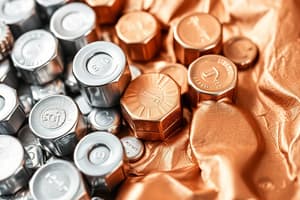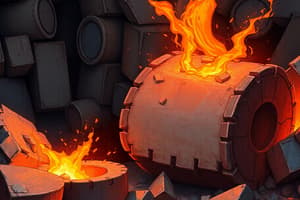Podcast
Questions and Answers
What property allows metals to be drawn into wires without breaking?
What property allows metals to be drawn into wires without breaking?
- Strength
- Malleability
- Lustre
- Ductility (correct)
Which of the following metals is classified as a precious metal?
Which of the following metals is classified as a precious metal?
- Iron
- Aluminum
- Copper
- Gold (correct)
What is a key characteristic of ferrous metals?
What is a key characteristic of ferrous metals?
- Resistance to corrosion
- Low density
- High conductivity
- Magnetic properties (correct)
Which structure is NOT common among metals?
Which structure is NOT common among metals?
What characteristic of metals causes them to have a shiny appearance?
What characteristic of metals causes them to have a shiny appearance?
Which metals are highly reactive and usually found in compounds?
Which metals are highly reactive and usually found in compounds?
What is the typical melting point characteristic of metals?
What is the typical melting point characteristic of metals?
Which type of metal is characterized by its low density and is used for lightweight applications?
Which type of metal is characterized by its low density and is used for lightweight applications?
What is responsible for the unique properties of metals?
What is responsible for the unique properties of metals?
Which of the following is a common application of metals?
Which of the following is a common application of metals?
What characteristic is enhanced in alloys compared to their pure metal counterparts?
What characteristic is enhanced in alloys compared to their pure metal counterparts?
What treatment processes are used to improve the mechanical properties of metals?
What treatment processes are used to improve the mechanical properties of metals?
What commonly causes the deterioration of metals?
What commonly causes the deterioration of metals?
Which of the following is NOT a method to combat corrosion?
Which of the following is NOT a method to combat corrosion?
Which metal alloy is created by combining copper and tin?
Which metal alloy is created by combining copper and tin?
What is the role of grain structure in metals?
What is the role of grain structure in metals?
Flashcards
Metal Conductivity
Metal Conductivity
Metals are good conductors of heat and electricity due to free-moving electrons.
Metal Malleability
Metal Malleability
Metals can be hammered or rolled into different shapes without breaking.
Metal Ductility
Metal Ductility
Metals can be drawn into wires without breaking.
Ferrous Metal
Ferrous Metal
Signup and view all the flashcards
Non-Ferrous Metal
Non-Ferrous Metal
Signup and view all the flashcards
Crystal Lattice
Crystal Lattice
Signup and view all the flashcards
Light Metal
Light Metal
Signup and view all the flashcards
Metal Properties
Metal Properties
Signup and view all the flashcards
Metallic Bonding
Metallic Bonding
Signup and view all the flashcards
Grain Structure
Grain Structure
Signup and view all the flashcards
Metal Alloys
Metal Alloys
Signup and view all the flashcards
Heat Treatment
Heat Treatment
Signup and view all the flashcards
Surface Treatments
Surface Treatments
Signup and view all the flashcards
Corrosion
Corrosion
Signup and view all the flashcards
Alloy Examples
Alloy Examples
Signup and view all the flashcards
Metal Applications
Metal Applications
Signup and view all the flashcards
Study Notes
Introduction to Metals
- Metals are a class of materials characterized by high electrical and thermal conductivity, malleability, ductility, and a lustrous appearance.
- They are generally strong and have a high melting point.
- Metals are composed of atoms arranged in a crystal lattice structure.
- The properties of metals are a result of the way electrons are shared among atoms within the lattice.
Types of Metals
- Ferrous metals: These metals contain iron as the primary component. Examples include steel and cast iron. Key characteristic is their magnetic properties.
- Non-ferrous metals: These metals do not contain iron as the primary component. They encompass a broad range of elements, exhibiting diverse properties.
- Light Metals: These metals have low density and are often used for lightweight applications. Examples include aluminum and magnesium.
- Precious Metals: These metals are typically characterized by their high value and resistance to corrosion. Examples include gold, silver, and platinum.
- Reactive Metals: These react quickly with other substances, frequently requiring specific handling and storage conditions. Examples include sodium and potassium.
- Transition Metals: Group of metals that exhibit a range of properties and are useful in various applications. Examples include copper, nickel, and zinc.
- Alkali Metals: These are highly reactive metals commonly found in compounds and not in elemental form.
Properties of Metals
- Electrical conductivity: Metals are excellent conductors of electricity due to the free movement of electrons within their crystal lattice.
- Thermal conductivity: They also transmit heat efficiently due to the same electron mobility.
- Malleability: Ability to be hammered or rolled into thin sheets without breaking.
- Ductility: Ability to be drawn into wires.
- Lustre: Shiny appearance resulting from reflected light.
- Strength: Generally strong and resistant to deformation.
- Melting and Boiling Points: Typically high melting and boiling points, indicating strong atomic bonds in the structure.
- Density: Varies greatly across different metals. Some are dense, while others are relatively light.
Structure of Metals
- Crystal lattice: Atoms in metals arrange in specific repeating patterns forming a crystal structure. Common structures include BCC (body-centered cubic), FCC (face-centered cubic), and HCP (hexagonal close-packed).
- Atomic bonding: Metallic bonding is responsible for the unique properties of metals. This involves the sharing of valence electrons among many atoms, creating a "sea" of electrons that holds the positive metal ions together.
- Grain structure: The arrangement and size of the crystal grains (crystallites) can significantly impact the mechanical properties of a metal.
Applications of Metals
- Construction: Structural components in buildings, bridges and other structures.
- Manufacturing: Machine tools, dies, and other industrial equipment.
- Transportation: Automobiles, aircraft, and other vehicles.
- Electrical components: Wires, electrical contacts, and circuit boards.
- Machinery: Machine parts, engines, and turbines.
- Jewelry: Precious metals in jewelry making.
- Food packaging: Metals such as tin and aluminum in food packaging.
Metal Alloys
- Alloys are mixtures of two or more metals, or a metal and a non-metal.
- Alloys often exhibit improved properties compared to the pure metals they comprise, such as increased strength, hardness, or corrosion resistance.
- Common examples of alloys include steel (iron and carbon), brass (copper and zinc), and bronze (copper and tin).
Metal Treatments
- Heat treatment: Processes like annealing, quenching, and tempering modify the microstructure and properties of metals.
- Surface treatments: Techniques like plating, painting, and powder coating improve a metal's durability and aesthetic appeal.
- Deformation treatments: Processes like rolling or forging change the size and shape of metals to improve their mechanical characteristics.
Corrosion of Metals
- Corrosion is the deterioration of a metal due to its chemical reaction with the environment.
- This can cause loss of strength and structural integrity, aesthetic damage, and a reduction in the useful life of a metal structure.
- Common methods to combat corrosion include using protective coatings, or choosing corrosion-resistant metals.
Studying That Suits You
Use AI to generate personalized quizzes and flashcards to suit your learning preferences.




